The Njoy Pothos is the plant you didn’t know you needed.
A beautiful Epipremnum aureum variety that really stands out from the Pothos crowd with its signature mottled white and green variegation and small, irregular leaves.
Its name – being comparable to early 2000’s SMS language – might make you cringe (Tks 4 2nite, did u Njoy? Ew…).
But, hopefully, its hardiness and yummy variegated leaves will help you overlook the flip phone flashbacks and revel in the delights that this plant has to offer.
Pothos N’joy, Njoy, or N joy, you ask? Well technically on the patent it states Pothos Njoy as one word so I’m going with that!
This smaller, bushier (and more ornamental-looking) variety has several advantages for both terrariums and the home – read on to find out more.
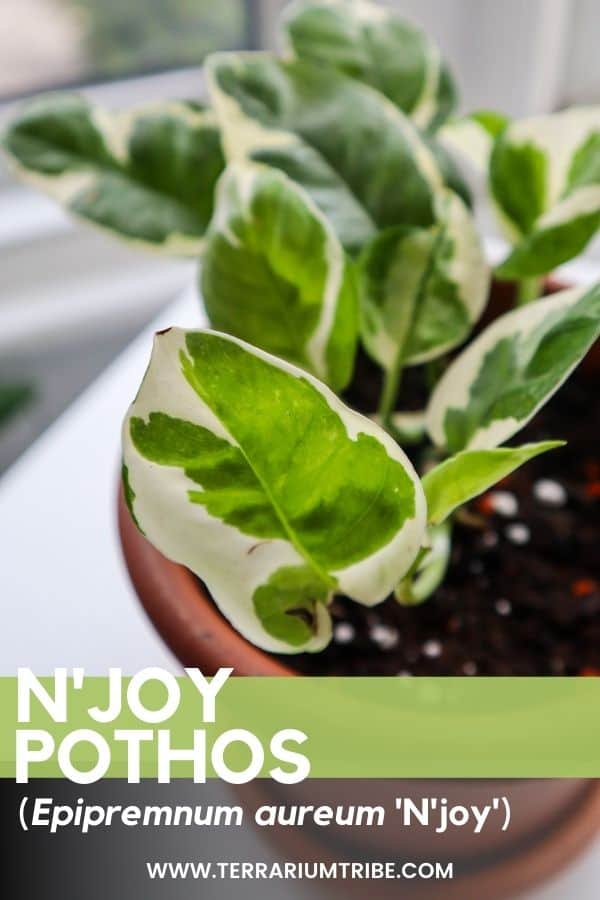
What is the Njoy Pothos? (& How it Compares)
While the Epipremnum aureum genus originates from the South Pacific Islands, the Njoy came into the world in 2002 after a naturally occurring branch mutation in a type of Marble Queen Pothos, believe it or not.
There’s very little family resemblance from what I can see, though (we might need to go on The Maury Povich Show and get a paternity test!).
Its leaves are so much smaller and varied in shape, and the variegation pattern is extremely different.
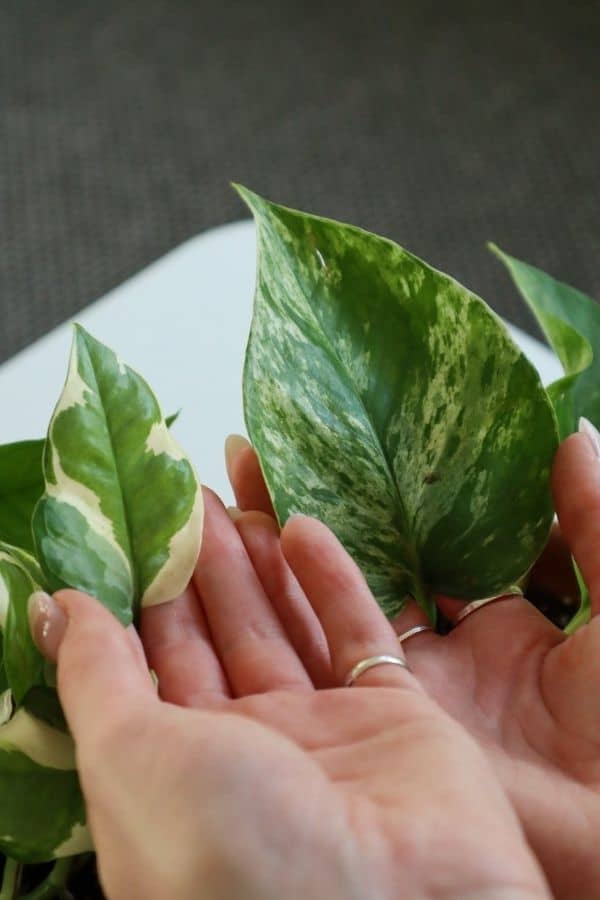
And, the “Devil’s Ivy” nickname the genus often goes by is very appropriate for this plant.
Out of all of the Pothos varieties, this little guy really looks like Ivy, in my opinion, with its characteristic green leaves and often white-edged variegation.
The Njoy is actually brought to you by the same guy who developed the Manjula Pothos – Dr Ashish Hansoti – whom we have to thank for many of our glorious indoor plants.
Sort of making the Njoy the Manjula’s older cousin – how exciting!
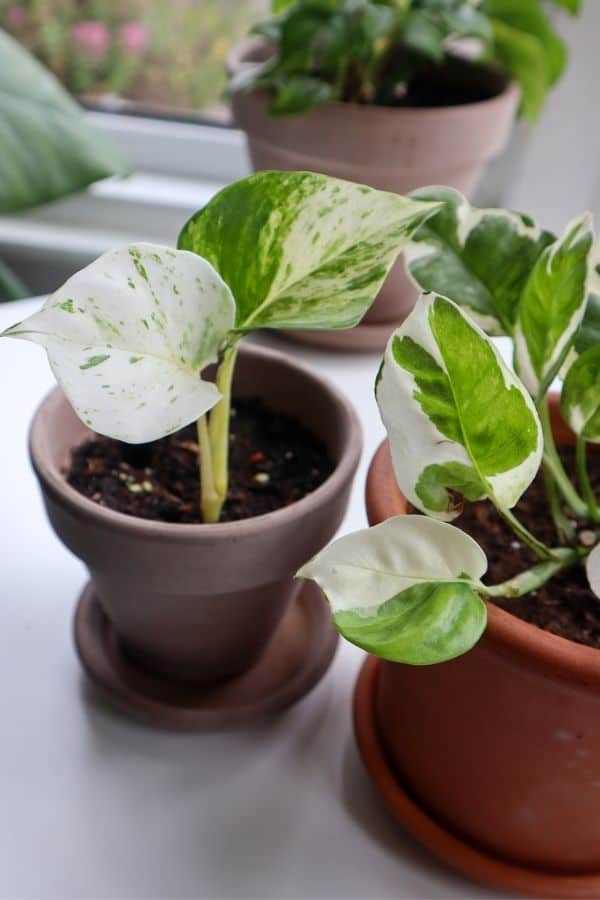
Where to Buy the Njoy Pothos
See the links below to purchase from reputable terrarium plant shops and marketplaces (may include affiliate links).
Njoy Pothos Care & Growth
At a Glance
| Plant Type | Vine, foliage, large |
| Lighting | Bright indirect light |
| Temperature | 50-95°F (10-35°C) |
| Watering | Moderate, even moisture |
| Humidity | Moderate to high humidity (60-90%) |
| Growth | 1ft+ Semi-vining |
Light
The Njoy Pothos was originally grown under the scorching Mumbai sun in a greenhouse with a shade cloth, allowing for 50% natural light to come through.
So, as this isn’t a naturally occurring variety in the wild, this is as close to a “natural” environment that we can try to replicate.
In the home, bright, indirect light is the gold standard. Meaning just a few feet away from a sunny window but not in the direct beams.
And, if you’re popping it in a terrarium build, terrariums and their plants are almost universally suited to this kind of indirect yet bright light.
Though full disclosure, I keep my Njoy on a South-facing windowsill, where it gets some direct light, and so far, my little fella is doing more than fine (though I don’t live in a particularly sunny place, unfortunately).
So this plant can tolerate quite the range (and probably won’t make a fuss with whatever you can give it), and you shouldn’t have any issues with a little direct light.
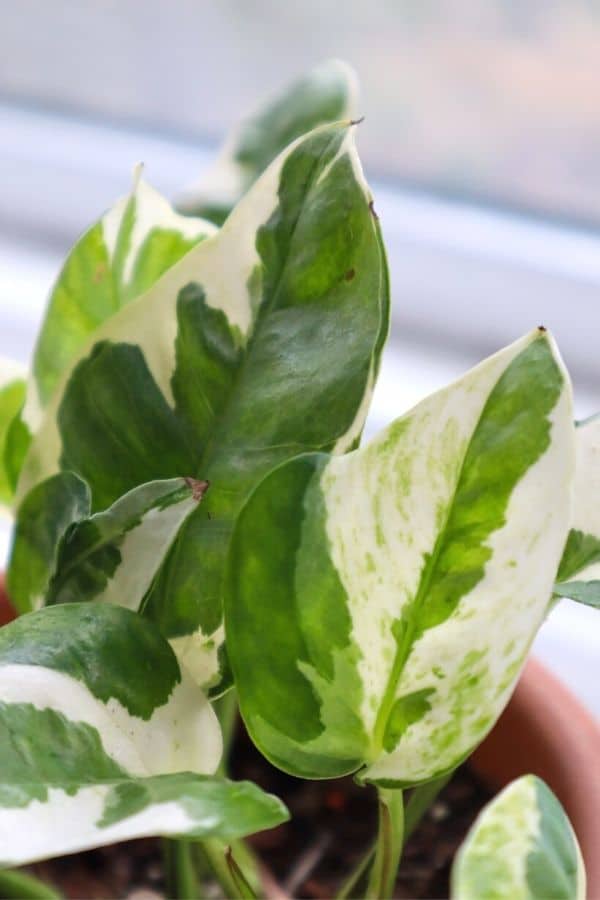
You’ll likely see brighter variegation if you can give the plant optimum lighting conditions, but if you’re lacking sunnier spots in the home (or they’re being hogged by fancier plants) this little guy will absolutely grow in lower light, you might just see slower growth.
Also, we don’t exactly live in medieval times – there are options! You can always pop it under a grow light to supplement with a little artificial light.
Watering
This tropical beauty loves plenty of moisture, but like most Pothos, they’re wonderfully forgiving too.
If the top of the soil is dry to the touch, then that’s my cue to give the Njoy a thorough watering. Though they won’t suffer if you forget for a few days.
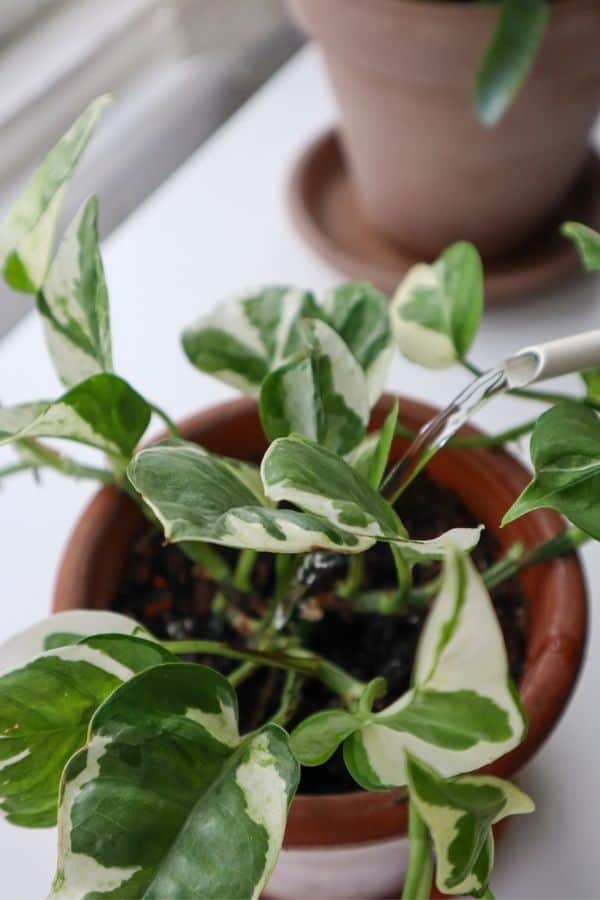
Just remember the number one rule of tropical plant club – Don’t talk about tropical plant club always use a pot with a drainage hole.
Let’s sing it from the rooftops, kids!
I know your local plant shop has the prettiest pots, but it’s not worth risking root rot. I just use a terracotta clay pot with a drainage tray, and it makes watering so much easier.
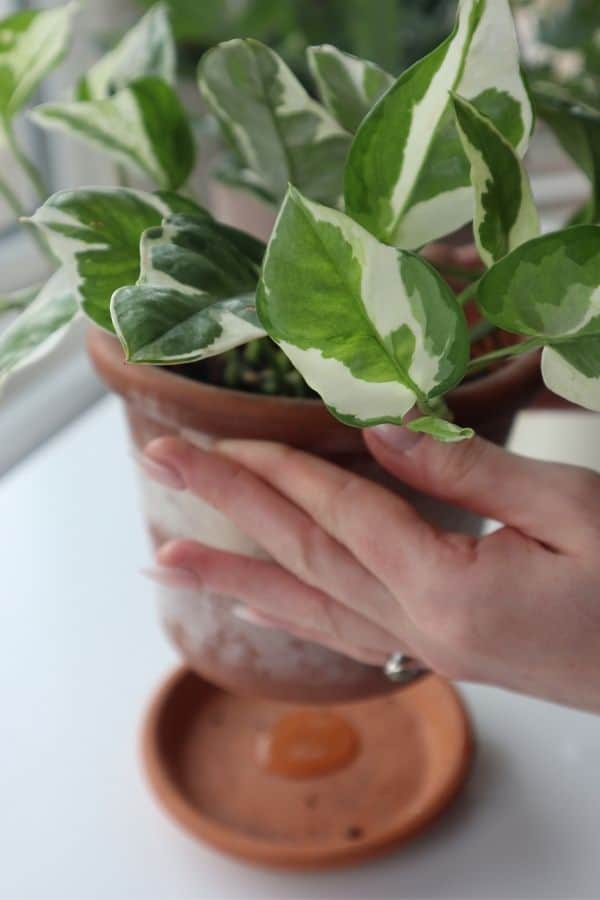
Same goes for a terrarium, a drainage layer will provide any excess water a place to go that won’t stress the plants roots out.
Having good drainage somewhat gives you more wiggle room with your watering, it’s less important to get the balance perfect because you won’t have your plant sat in wet soil.
Substrate / Soil
Those in the Pothos family aren’t quite as demanding as some of their Aroid cousins when it comes to substrate choice, but don’t let that stop you from selecting something with the best qualities.
Any typical Aroid mix or tropical terrarium mix should do the trick nicely.
In terrariums, it’s more important to get this right, as your margin of error is much smaller.
You’ll want to achieve a mix that balances water retention and drainage to keep your Njoy Pothos happy and healthy. My typical mix uses a coco coir base with orchid bark, earthworm castings, and usually pumice or perlite.
👉 If in doubt, give our tropical substrate mix a look.
Temperature & Humidity
The Njoy was originally grown in temperatures ranging between 54-95°F (12-35°C), which pretty much encompasses all homes, so it isn’t a picky plant.
And it’s been recorded tolerating an even wider temperature range – so basically, it’ll take anything you can give it without complaint, and you probably don’t need to give much thought to the temperature.
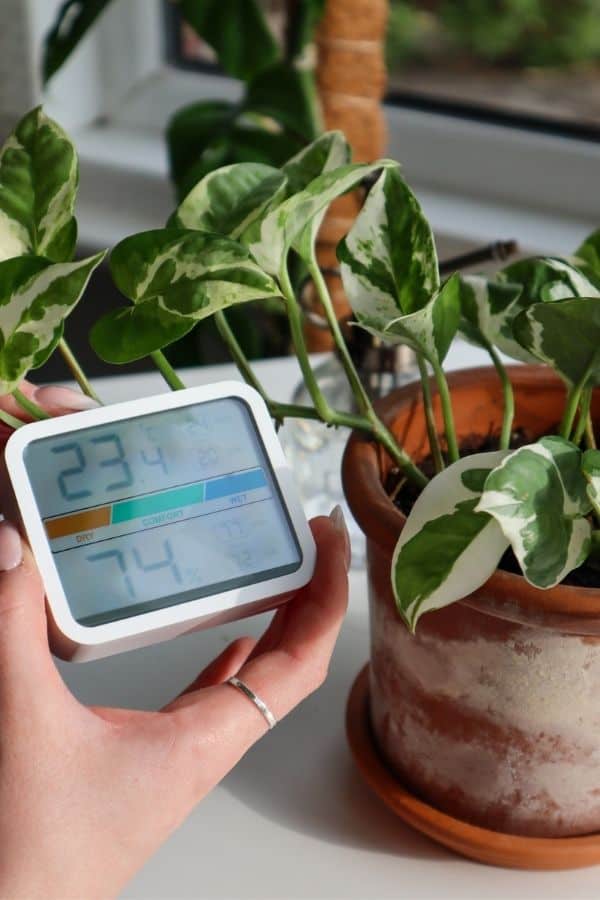
Humidity-wise, this baby is tropical with a capital T.
Anything in the range of 60-90% will be perfect. So if that’s not something you can maintain, pop it by a humidifier or stick it in a terrarium.
I keep my Njoy in a room with around 75% humidity, and it absolutely loves it – there are even some little aerial roots forming.
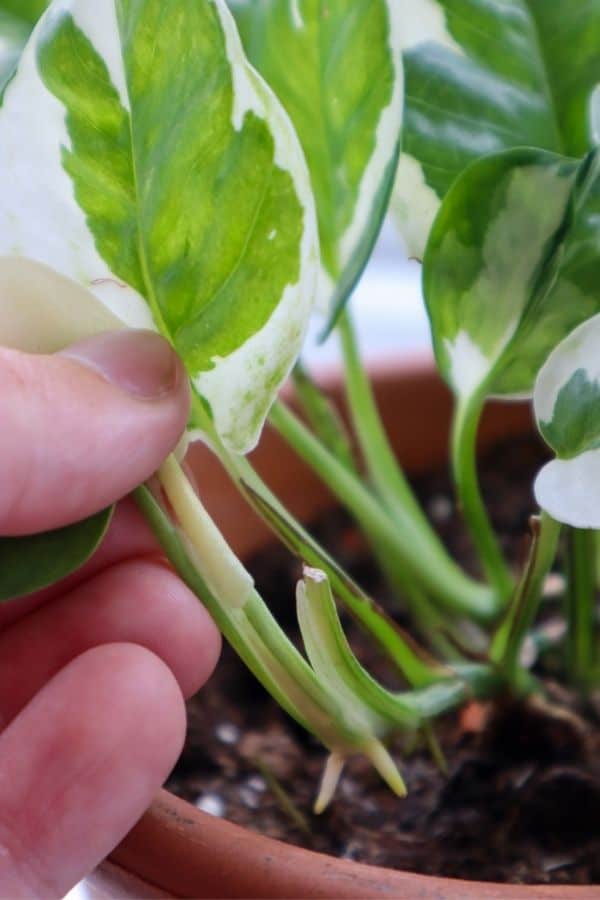
Growth
This lovely plant shows off a growth rate that absolutely takes after its speedy Marble Queen mother, plus a more unique compact growth pattern similar to its Manjula cousin.
Making a rapid yet compact grower. Best of both worlds, right?
Unlike most Pothos, the Njoy (like the Manjula) has super short leaf internodes, which gives you a much fuller, bushier plant.
A bushy vining plant, you say? What’s not to love?
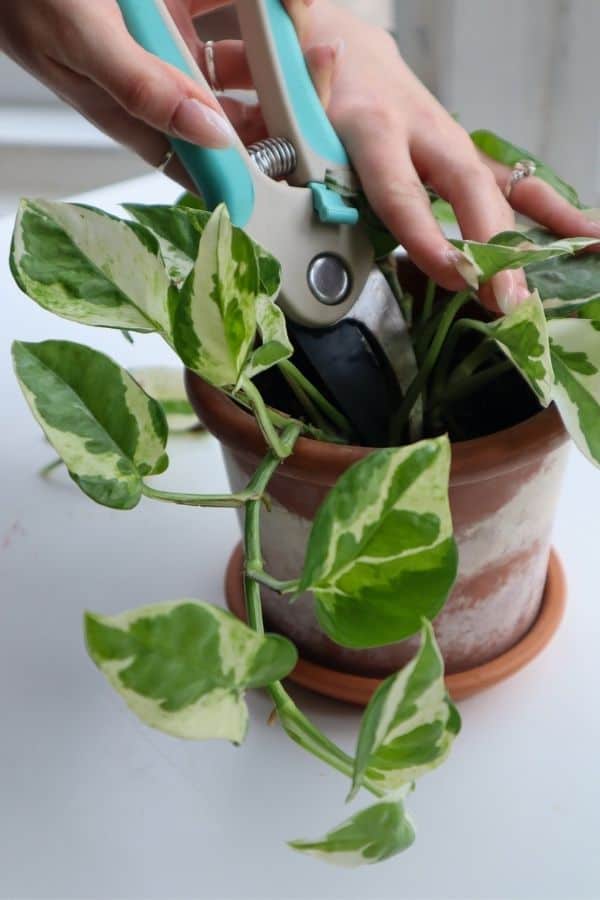
So, as you’d expect, the Njoy looks absolutely dreamy as a hanging plant. It can be trained to climb a moss pole or such, too, but being so bushy, it looks better trailing than as a climbing plant, in my humble opinion.
In a terrarium, make sure you have your scissors at the ready for the regular pruning this plant will need. Though, I think it’s really worth the maintenance for the striking variegation, and its leaf size really lends itself to life inside the glass!
All Epipremnum aureum are aggressive climbing plants that really don’t need encouragement on the growth front, and the Pothos Njoy is described as a light feeder (meaning fertilizer isn’t necessary).
So, if your Pothos Njoy isn’t growing fast, check that you’ve got the conditions nicely balanced before you go giving it fertilizer. I only fertilize my Pothos plants once or twice a year, and that’s probably overdoing it.
Propagation
As always, Pothos Plants are super easy to propagate via stem cuttings in water.
Grab some scissors and snip beneath the leaf node, then whack that bad boy in a jar of water and stare at it longingly, waiting for roots to form.
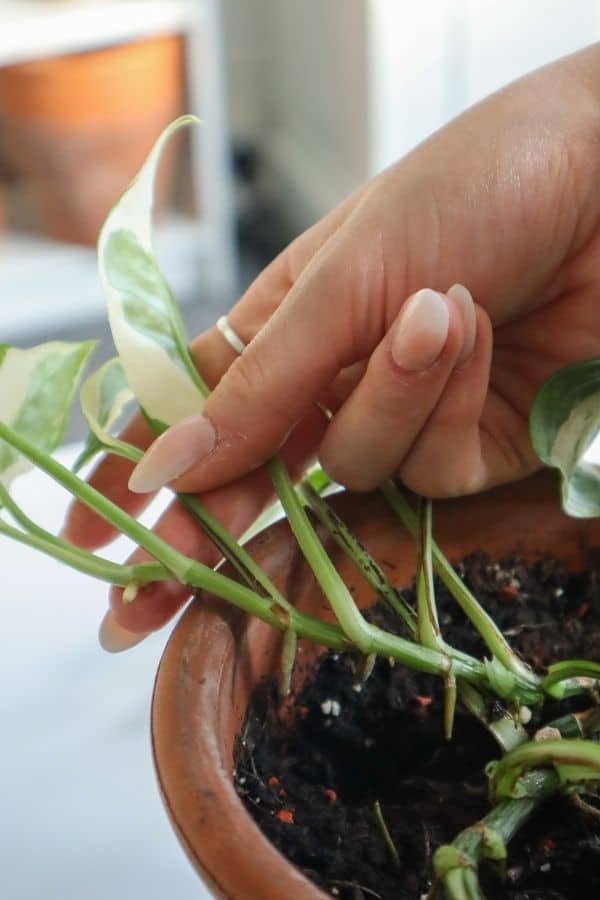
It should take somewhere in the region of 3-6 weeks, though I just like to leave it until my main root has little baby roots coming from it.
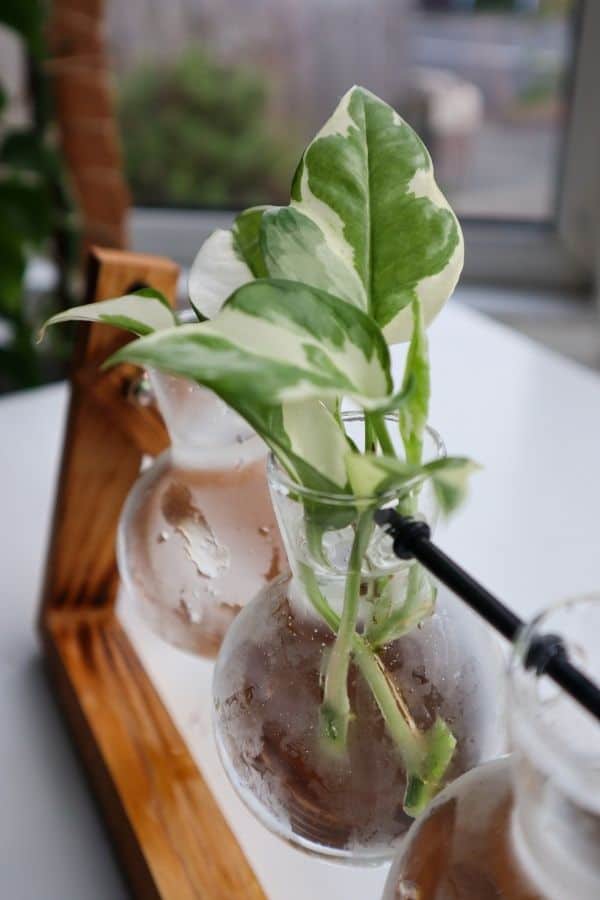
Following that, plant up your rooted cutting into a nice chunky potting mix, as detailed above, and there you have it.
It’s that simple – so if you own one Pothos, it won’t take long till you own a hundred and live in a house closely resembling a rainforest.
Varieties & Similar Plants
Where on earth do I begin? There are so many beautiful Pothos varieties to adorn your home or terrarium with.
I currently have a Golden Pothos, Neon Pothos, Marble Queen Pothos, Manjula Pothos, Cebu Blue Pothos, and a Satin Pothos.
And no, I’m nowhere near finished with my collection…
I have my sights set on the Pearls and Jade Pothos next, but I’m struggling to get my eager hands on one in the UK (edit: found one!).
Frequently Asked Questions
Yellow leaves could be a sign of anything, unhelpfully. It could be just a normal sign of your plant getting rid of old leaves to focus on new ones, but it could also be something more sinister. More commonly, yellow leaves are an indicator of root rot due to consistent overwatering. Make sure you have drainage and well-draining soil, and never let your plant sit in excess water.
Again, browning could be an indicator of several different things – here are some questions to ask: Is the plant getting too much direct light? Are you letting it get too dry (bone dry) between waterings? Are you using too much fertilizer? Is the room humid enough? Remember, bright indirect light is best, and the soil likes to be lightly moist – not dry and not wet.
Super simple answer to this one – he’s thirsty! Give your plant a good glug of water, and make sure you finger test the soil regularly in between waterings, and don’t let the soil get bone dry.
Yes. Like many beloved houseplants, it’s a member of the aroid family and will cause digestive irritation and other nasty symptoms if ingested. So if any member of your household (human or otherwise) might have a nibble, either keep it safely in a terrarium or give it a miss.
Yes – there was actually a study done by NASA that looked at Pothos Plants and their ability to remove common household toxins from the air.
